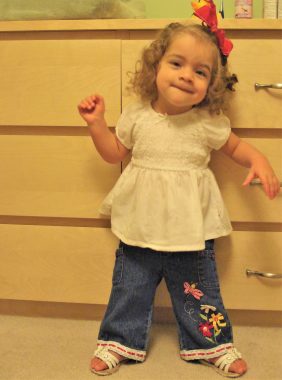Staying Wishful While Waiting for Our Angel to Walk
Written by |

Walking is something many of us take for granted. It seems so simple — you just put one foot in front of the other and go. But as the parent of a child with Angelman syndrome, it’s not always that easy.
Our 11-year-old Angel, Juliana, has been walking for almost eight years. I write about this milestone every year as Thanksgiving approaches, because Juliana’s ability to walk is a gift I am eternally grateful for. Our quality of life was significantly boosted as Juliana’s mobility evolved.
Numbers don’t mean everything
Ataxia, which is a loss of muscle control or voluntary movement, can inhibit an Angel’s ability to walk. Statistics about Angels and walking are somewhat grim. Angels might not walk until they are 3 or 4 years old. In addition to this difficult reality, more than 95% of Angels will struggle with balance and movement challenges.
Just this year, the Foundation for Angelman Syndrome Therapeutics, or FAST, funded more research to assess gait and mobility issues in Angelman syndrome. While the research is promising, medical interventions to assess and improve motor skills will take time.
Facing these statistics and limitations can be challenging for parents. But resilience and the right encouragement can go a long way toward hoping, believing, and waiting for an Angel to walk.

At 2, Juliana stands up with the support of a dresser behind her. (Photo by Sabrina L. Johnson)
Perhaps it’s easier for me to be strong in my position now that Juliana is walking. But I think what previously helped to keep my faith strong was hearing and reading stories of other Angels walking. I felt certain that Juliana would walk one day, I just didn’t know when.
And then, one day at a Home Depot when Juliana was almost 4, she decided to take off and walk toward me. Years later, I’m still a little tickled that she chose Home Depot of all places to find her footing.
Her walking in the store that day caught us completely off guard. Of course, we had been practicing with her. As an extension of her occupational therapy, we would practice steps and do exercises to strengthen her legs. We were just waiting and remaining encouraged.

At 9, Juliana runs through the Christmas tree section of a store. (Photo by Sabrina L. Johnson)
Finding strength for the wait
The affirmations of friends and family strengthened our resolve. We also received strong encouragement from the parents of another Angel we knew. Their daughter started walking out of the blue while they were hanging out in their backyard.
But perhaps the truest hope for me came from a little red-haired girl I’ve never met. That sweet Angel was about 10 when I happened upon her parents’ blog.
I haven’t been able to find the blog again, but I vividly remember the pictures her parents posted of her walking across a bridge. They also shared stories about how their Angel could run. I was hopeful for the walking, but running seemed unimaginable back then.
I held on to those stories while waiting for the day that Juliana would have her own. Waiting for those first steps can seem like a lifetime. But we never gave up hope.
Our own story of hope
Today, just like the little red-haired girl, Juliana walks and runs. For families who are waiting for their Angel to walk, I say don’t lose heart.
When I see Juliana running, I am reminded of her early days of limited mobility. The days when we carried her tucked in our arms like a little present have passed. And gone is the large, clunky walker that barely fit in our car.
As difficult as those moments were, I don’t want to forget them. So, each year, I write a little something in hopes that I will be a small voice of comfort for a family waiting for their Angel to walk — and hopefully run, too.
***
Note: Angelman Syndrome News is strictly a news and information website about the disease. It does not provide medical advice, diagnosis, or treatment. This content is not intended to be a substitute for professional medical advice, diagnosis, or treatment. Always seek the advice of your physician or other qualified health provider with any questions you may have regarding a medical condition. Never disregard professional medical advice or delay in seeking it because of something you have read on this website. The opinions expressed in this column are not those of Angelman Syndrome News, or its parent company, Bionews, and are intended to spark discussion about issues pertaining to Angelman syndrome.







Leave a comment
Fill in the required fields to post. Your email address will not be published.